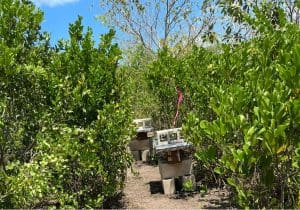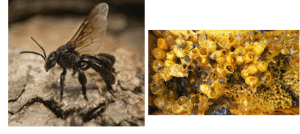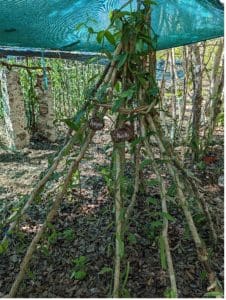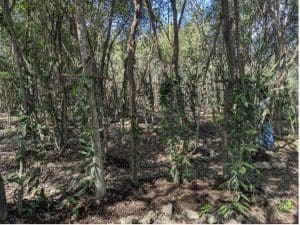To address deforestation and stimulate production of non-timber forest products for communities within the Mayan Forest Zone, the second largest area of tropical forest in the Americas (which includes large areas of Belize, Guatemala and the Yucatán Peninsula), David MacFarlane is working with the forest — not against it.

MacFarlane, a professor within Michigan State University’s Department of Forestry, said he was invited with a group of entomologists in February 2020 to visit the Yucatán Peninsula in Mexico to help examine declining bee populations in light of the changing forest landscape.
“I was the only person who wasn’t an entomologist and didn’t study bees who was invited from MSU,” MacFarlane said. “I was invited because I’m a professor of forestry, and I have international experience (on forest conservation research).”
After speaking with local researchers and policymakers, MacFarlane said it became evident the negative impact deforestation was having on native bee populations.
The Yucatán Peninsula’s landscape, naturally covered by forests, has rapidly been changing because of pressures to urbanize it, as well as to clear it for agricultural purposes. That’s bad news for the bees that rely upon the forest habitats to survive.
So, instead of clearing the forest for other uses, MacFarlane proposed a project to reinvent ancient Mayan practices that were once commonly performed within the forest. While Mayan people and their historical cultivation practices are still in the area today, their practices are under intense pressure to change from global market competition.
“The Mayans traditionally gardened the forest,” he said. “The way they survived in this harsh climate was to keep the forest layers intact, but then they cultivated the forest and opened up clearings for more annual crops, harvesting fruits and herbs.”

MacFarlane is conducting research on “analog” forest systems, which aims to economically and socially strengthen rural communities. This research emphasizes conservation of forests through the sustainable cultivation of high-value, organic forest crops informed by the traditional concept of Mayan “Forest Gardens.”
“If we can increase the value of the forest and land — make the forest more valuable to people — then they would be less likely to clear them and convert them for other land uses,” said MacFarlane, whose pilot research is supported by MSU AgBioResearch.
As part of the bee project, MacFarlane has been working with researchers to conduct two case studies: The first is in the coastal mangrove forests of the region on honey production, and the second is on vanilla production in the Yucatán Peninsula’s inland forests.
Mangrove forests not only protect the land from coastal storms, but they’re also home to 80% of the seafood species in the region.
“If we lose the mangrove forests, we’ll lose most of our seafood in those areas,” MacFarlane said.
Working with local women’s groups in coastal communities, MacFarlane and his Mexican colleagues Jorge Herrera from the Center for Research and Advanced Studies of the National Polytechnic Institute and Javier Quezada from the Universidad Autónoma de Yucatán built special nest boxes to attract a native stingless bee species known for producing honey. Producing honey from these bees, known in Mayan as “Sak Xic,” also helps to pollinate black mangroves.

Therefore, the relationship between the bees and the forests is reciprocal: The bees use the forests as habitats to produce honey, and the forests depend on the bees for regeneration.
The first boxes were introduced to the forests in January and have already resulted in honey production. MacFarlane said the study might be the first to produce mangrove honey from a native stingless bee species.
Ultimately, he wants the people of these communities to continue using this system to harvest honey and generate income to add more value to their local forests.
For the second study, MacFarlane and Quezada’s lab are experimenting with forest-grown vanilla — a high-value crop traditionally native to the region’s forests but introduced overseas after the Spanish conquered the territory. Eighty percent of all vanilla is now grown in Madagascar.
Vanilla is an orchid vine which grows on trees that originally produced beans through natural pollination. Today, it is mainly grown on wooden poles and pollinated by hand, said MacFarlane.

“We’re working with agronomists to reintroduce vanilla into patches of forest and to see if they can be grown organically in the forest — the way that nature intended them to grow,” MacFarlane said.
The first vanilla vines under study, planted about two and a half years ago, flowered this year. MacFarlane and his team are trying to figure out which native orchid bee species pollinate vanilla and how much production could come from natural pollination.
MacFarlane said if the bees the researchers are studying were to naturally pollinate the orchid vines, the labor costs to hand pollinate them would decrease.
Through their initial research, the scientists discovered that natural pollination is occurring to a degree. However, it remains unknown which species is doing it.
“The bees we thought were going to pollinate (the vanilla orchids) haven’t so far, but the Mexican students observing the flowers didn’t see which species did,” MacFarlane said. “Something naturally pollinated the vanilla, we just don’t know what it is.”

He said new vanilla vines will soon be planted within other communities to further advance the research.
If these pilot programs are successful, MacFarlane said he hopes that other people will replicate them on their own land.
“Think of Michigan,” MacFarlane said. “A lot of people produce maple syrup (using forests). They could do other things with that land, right? They could clear it and put a cabin on it. They could clear it and put a cornfield on it, but they keep their sugar bush intact because they want to tap it for maple syrup.”
This story was originally posted on the AgBioResearch website.
About the MSU Innovation Center:
The MSU Innovation Center is dedicated to fostering innovation, research commercialization, and entrepreneurial activities from the research and discovery happening across our campus every day. We act as the primary interface for researchers aiming to see their research applied to solving real-world problems and making the world a better place to live. We aim to empower faculty, researchers, and students within our community of scholars by providing them with the knowledge, skills, and opportunities to bring their discoveries to the forefront. Through strategic collaborations with the private sector, we aim to amplify the impact of faculty research and drive economic growth while positively impacting society. We foster mutually beneficial, long-term relationships with the private sector through corporate-sponsored research collaborations, technology licensing discussions, and support for faculty entrepreneurs to support the establishment of startup companies.
Contact Us to learn how to partner with the MSU Department of Foresty.
